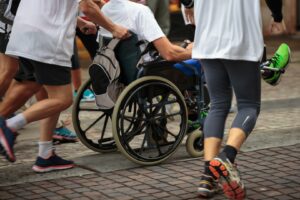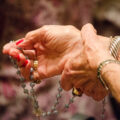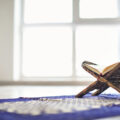Do religions objectify people with disabilities? Part 1: in theory
Do religions objectify people with disabilities? Part 1: in theory
In religions and societies, people with disabilities have equally suffered from idealisation and rejection. Today, do theologies do a better job of recognising that they are humans?
“Disabled children aren’t burdens – or angels.” Journalist s.e. smith[1] say it all in their blog post: the way disability is currently discussed is harmful. Tolerating or admiring people with disabilities as if they were ‘living lessons’ is dehumanising. Not making space for their own needs, wants, wishes, and dreams, “talking over and about” them as if they were things, is objectifying.[2]
Religions have long provided meaning to sufferings of all kinds. Those caused by disabilities, like isolation, were also interpreted and made sense out of. Do these narratives successfully take into account the humanity of disabled people? This would be the case if religions found a middle ground between idealisation, well-meaning indifference, and rejection.
Disability in myths
Anthropologist of disability, Henri-Jacques Stiker, identified different interpretations of disability within Jewish, Christian, and Muslim traditions. Disability is either understood as an indication of transgression and sin, or as a mark of purity. In the Bible, it is also a sign of divine election. In fact, biblical characters with a disability have exceptional destinies. Some characters with a disability are even patriarchal references for God; the God of the Bible is known as ‘God of Abraham, Isaac, and Jacob’, while Isaac was blind and Jacob limped.[3]
Stiker explains that “[impairment] underlines that these characters and the people they are the founders or leaders of, are branded with the identifying marks of limit, lack, strangeness, weakness, that are the very condition of their extraordinary nature; the very condition of their people’s life.”[4] In other words, in these myths, disability is a metaphor for the human condition.
The Muslim tradition also links social leadership, extraordinary relationship to God, and disability. The prophet is described as a beautiful, strong, and very smart man, who had some peculiarities. Firstly, reports have acknowledged that he was of frail health. Secondly, there were stories to suggest that Muhammad had had an open-heart surgery by an angel to purify him, that he had a small hump on his back, that he had remained ‘petrified’ after a fight with angel Gabriel, and got into trances.[5]
Disability in beliefs
These religious stories describe disability as if it meant ‘standing out of the crowd’. The interpretations of these narratives form religious beliefs. Such beliefs are part of collective representations that participate in alienating people with disabilities. This is the hypothesis formulated by Catholic theologian Talitha Cooreman-Guittin, as numerous disabled people of faith have asked her: “Why does no one want to be friends with us?” She assumes that the deficiencies, in themselves, are only partly responsible for the isolation they experience.[6]
For Cooreman-Guittin, it is the way religious people define perfection that needs addressing. The belief that humanity was created perfectly ‘in God’s image’ is used to demonise disability. Interpreting the myth of the world’s creation by God, Jews and Christians have assumed that sin caused all sorts of disorders and misfortunes, including disabilities. From then on, some people conformed to God’s image, while others failed. Cooreman-Guittin remains optimistic, arguing that once this belief is pinned down, it can no longer be perpetuated. People with differing mental and physical capabilities will no longer be seen as deviations from God’s image.[7]
Diverse theologies of disability are now on the rise. They unify around the renewed belief that deficiency is an integral part of being human. Disability is reframed as being normal: after all, it is common. For example, around 10 million French people have at least one disability.[8] As a comparison, 5.5 million French viewers watched Barbara Pravi reach second place in the Eurovision Song Contest[9] in 2021,[10] making disability almost twice as common as being a Eurovision fan.
Towards ‘disability-friendly’ theologies?
So, do religious myths and beliefs successfully take into account the humanity of disabled people? Characters, as literary beings, are not humans: they are great people (whether real or fictional) transformed into stories. It turns out that characters with disabilities, in religious stories, have exceptional destinies.[11] This could have caused religions to idealise those concerned.
On the contrary, stories of disabilities have been overlooked. Beliefs around disability have rather demonised and alienated people with variant capabilities. This is, however, beginning to change as theologians point out that disability and vulnerability in general are part of the human condition.[12] The objectification of disabled people in theology is therefore regressing.
The erasure of women in religions has lost ground ever since theologians became aware that there were women in their sacred texts. Stiker suggests that as soon as they notice there also are disabled characters, they will gradually become able to take disability into account when talking about God.[13]
In a next article, we will assess the way religions address people with disabilities. What are the tangible impacts of these evolving theologies?
Want to read more about similar topics? Go to the EARS Dashboard and get free weekly updates.
Sources
[2] Disabled Children Aren’t Burdens — or Angels
[3] Henri-Jacques Stiker, Religions et handicap. Interdit, péché, symbole, Editions Hermann, 2017
[4] Henri-Jacques Stiker, Religions et handicap. Interdit, péché, symbole, Editions Hermann, 2017, p.90
[5] Henri-Jacques Stiker, Religions et handicap. Interdit, péché, symbole, Editions Hermann, 2017
[6] Talitha Cooreman-Guittin, Catéchèse et théologies du handicap : ouvrir des chemins d’amitié au-delà des barrières de la déficience, 2020
[7] Talitha Cooreman-Guittin, Catéchèse et théologies du handicap : ouvrir des chemins d’amitié au-delà des barrières de la déficience, 2020
[8] Population handicapée en France, INSEE, 2007
[9] Barbara Pravi – Voilà – LIVE – France 🇫🇷 – Grand Final – Eurovision 2021
[10] Eurovision 2021 : record d’audience pour le concours sur France 2, au plus haut depuis 10 ans
[11] Henri-Jacques Stiker, Religions et handicap. Interdit, péché, symbole, Editions Hermann, 2017
[12] Talitha Cooreman-Guittin, Catéchèse et théologies du handicap : ouvrir des chemins d’amitié au-delà des barrières de la déficience, 2020
[13] Henri-Jacques Stiker, Religions et handicap. Interdit, péché, symbole, Editions Hermann, 2017






